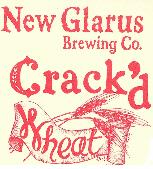“Here’s to the bright New Year
And a fond farewell to the old;
Here’s to the things that are yet to come
And to the memories that we hold.”
New Year’s Eve is a night for toasts. It’s a night to share with friends and raise a glass of something special to commemorate the old and usher in the new. Traditionally, this glass would be filled with champagne. There is nothing wrong with that. Sparkling, spritzy, crisp, and fruity, champagne is certainly an appropriately festive beverage. But there are several celebratory beers that share those festive attributes with champagne, making them the perfect partner to your New Year’s toast. So why not ring in the New Year with beer?
 When talking toasts, two beers come immediately to mind, Deus Brut des Flanders and Eisenbahn Lust. Both of these sparkling beers are brewed and bottled using the méthode Champanoise. After initial fermentation is complete, the beers are re-fermented in the bottle through the addition of yeast and sugar. During this secondary fermentation the bottles are gradually tilted until they are in the upside-down position, a process known as riddling or remuage. This allows the yeast sediment to settle into the neck of the bottle. The next step of the process, dégorgement, involves freezing the bottle neck and then removing the frozen yeast plug. Finally the bottles are topped off with finished beer and corked. This complex and costly process results in beers that are champagne-like in presentation, but all beer in flavor with a crisp, dry finish. Eisenbahn Lust is from Brazilian brewery Cervejaria Sudbrack. Deus Brut des Flanders is from the Belgian Brouwerij Bosteels. Serve these beers a bit colder than you would other craft beers. They are best appreciated from a champagne flute at 36° to 39° F.
When talking toasts, two beers come immediately to mind, Deus Brut des Flanders and Eisenbahn Lust. Both of these sparkling beers are brewed and bottled using the méthode Champanoise. After initial fermentation is complete, the beers are re-fermented in the bottle through the addition of yeast and sugar. During this secondary fermentation the bottles are gradually tilted until they are in the upside-down position, a process known as riddling or remuage. This allows the yeast sediment to settle into the neck of the bottle. The next step of the process, dégorgement, involves freezing the bottle neck and then removing the frozen yeast plug. Finally the bottles are topped off with finished beer and corked. This complex and costly process results in beers that are champagne-like in presentation, but all beer in flavor with a crisp, dry finish. Eisenbahn Lust is from Brazilian brewery Cervejaria Sudbrack. Deus Brut des Flanders is from the Belgian Brouwerij Bosteels. Serve these beers a bit colder than you would other craft beers. They are best appreciated from a champagne flute at 36° to 39° F.
Orval, a Trappist beer from the monks at the Abbey Notre-Dame d’Orval in Belgium is another beer that has the festive fizz and dry finish that makes for a great toasting beer. Truly one of the world’s great beers, Orval pours a light orange with a thick, mousse-like white head. Its flavor is a complex blend of fruit, peppery spice, and assertive bitterness. A shot of wild yeast at bottling gives this beer a light leathery barnyard character that really sets it off. Check the date on the bottle. This beer continues to develop with age and older bottles will have more of the funky notes than younger. It’s a matter of taste which one you prefer. I would opt for an older bottle if you can find one.
 Beers from the Lambic family of Belgian sour ales can also make delightfully sparkling toasting beers. Lambics are wheat-based, spontaneously fermented brews that feature fruity, cider-like flavors with layers of barnyard funkiness and bright, tart acidity. Fruited versions, usually raspberry or cherry, add additional depth. For great toasting lambics look for Boon Mariage Parfait Gueuze, a deliciously sour blended lambic from Brouwerij Boon. Two lambics worth seeking out from Brasserie Cantillon are Iris, a spritzy, light-amber version made with 100% pale-ale malt and a blend of fresh and aged hops and St. Lamvinus that blends two and three year old lambics with merlot and cabernet-franc grapes. If the funkiness of a traditional lambic is too much for you, the sweetened fruit lambics from Lindemans would make terrific and colorful beers for bringing in the New Year.
Beers from the Lambic family of Belgian sour ales can also make delightfully sparkling toasting beers. Lambics are wheat-based, spontaneously fermented brews that feature fruity, cider-like flavors with layers of barnyard funkiness and bright, tart acidity. Fruited versions, usually raspberry or cherry, add additional depth. For great toasting lambics look for Boon Mariage Parfait Gueuze, a deliciously sour blended lambic from Brouwerij Boon. Two lambics worth seeking out from Brasserie Cantillon are Iris, a spritzy, light-amber version made with 100% pale-ale malt and a blend of fresh and aged hops and St. Lamvinus that blends two and three year old lambics with merlot and cabernet-franc grapes. If the funkiness of a traditional lambic is too much for you, the sweetened fruit lambics from Lindemans would make terrific and colorful beers for bringing in the New Year.
My final recommendation for solemnizing the moment of the year’s change is Saison. One characteristic of this Belgian farmhouse style ale is effervescent carbonation and a huge fluffy, white head. It will look great in a champagne flute. My favorite saison is Fantôm Black Label from Brasserie Fantôm. This is a wonderfully complex, fruity beer with a bone-dry finish. Touches of wild yeast funk give it a bit of a festive edge. Another great one that just recently came available is Boulevard Brewing’s Tank 7 Saison. Fuller bodied and more fruity than Fantôm, this is a fantastic beer for raising in a toast.
Happy New Year!

 I recently heard a
I recently heard a 


